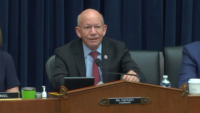The drive for a new Water Resources Development Act (WRDA) is gaining momentum on Capitol Hill with the rollout of a $5-billion proposal in the House. But the bill, introduced May 23 by Transportation and Infrastructure Committee Chairman Bill Shuster (R-Pa.), focuses on only U.S. Army Corps of Engineers projects and policies. The version that a Senate committee cleared in April is much broader. It may be difficult to reconcile the two and produce a final compromise measure this year.

Shuster
Shuster had signaled that he would propose a slimmed-down bill. John Doyle, special counsel with law and lobbying firm Jones Walker LLP, says the committee “produced a streamlined bill, a relatively narrowly crafted bill … as they said they were going to do.”
The House bill and the Senate Environment and Public Works Committee’s version each authorize about $5 billion for new Corps flood-control, navigation, environmental restoration and other projects that have received the Army chief of engineers’ recommendations. While the House measure authorizes 28 projects with “chief’s reports,” the Senate panel’s bill authorizes 27. Those funds are subject to annual appropriations. The largest authorization in each bill is $967.4 million for an environmental restoration project in Florida’s Everglades.
But the Senate bill also deals with U.S. Environmental Protection Agency drinking-water and wastewater programs. It would provide $220 million to help Flint, Mich., and other areas facing water emergencies, plus $1.4 billion over five years to help disadvantaged communities comply with the Safe Drinking Water Act. It also would authorize $1.8 billion for sewer-overflow grants and, most dramatically, create a trust fund for drinking-water and wastewater infrastructure.
Floor action still lies ahead, but lawmakers want to return to passing new WRDA bills every two years—something the American Association of Port Authorities is pleased to see. Doyle says they generally were on a two-year timetable from the late 1960s until the early 1990s. But the 2014 water measure was signed more than six years after the previous legislation became law.




Post a comment to this article
Report Abusive Comment